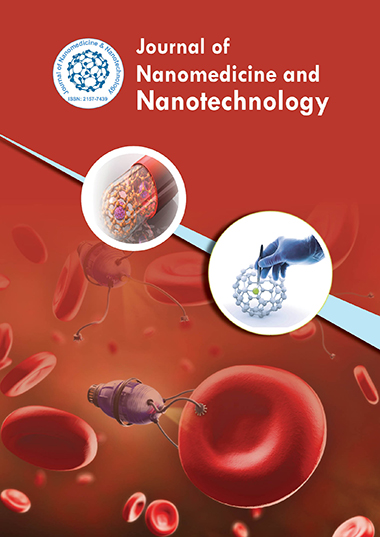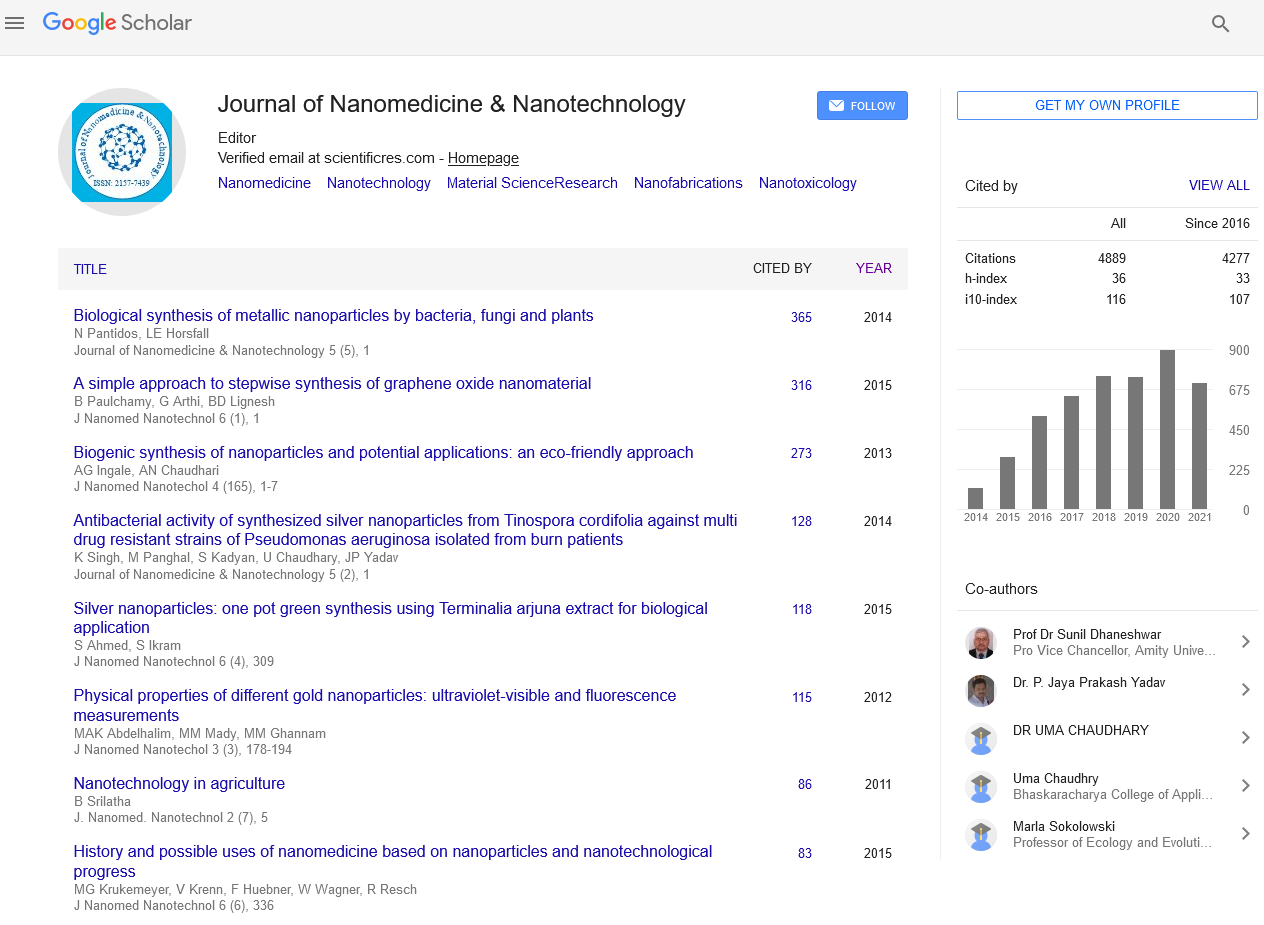Indexed In
- Open J Gate
- Genamics JournalSeek
- Academic Keys
- JournalTOCs
- ResearchBible
- China National Knowledge Infrastructure (CNKI)
- Scimago
- Ulrich's Periodicals Directory
- Electronic Journals Library
- RefSeek
- Hamdard University
- EBSCO A-Z
- OCLC- WorldCat
- SWB online catalog
- Virtual Library of Biology (vifabio)
- Publons
- MIAR
- Scientific Indexing Services (SIS)
- Euro Pub
- Google Scholar
Useful Links
Share This Page
Journal Flyer

Open Access Journals
- Agri and Aquaculture
- Biochemistry
- Bioinformatics & Systems Biology
- Business & Management
- Chemistry
- Clinical Sciences
- Engineering
- Food & Nutrition
- General Science
- Genetics & Molecular Biology
- Immunology & Microbiology
- Medical Sciences
- Neuroscience & Psychology
- Nursing & Health Care
- Pharmaceutical Sciences
Editorial - (2024) Volume 15, Issue 5
Biocompatibility and Toxicity Studies of Nanomaterials Understanding Risks and Safety
Renjiro Matsuda*Received: 03-Sep-2024, Manuscript No. jnmnt-24-27230; Editor assigned: 05-Sep-2024, Pre QC No. jnmnt-24-27230 (PQ); Reviewed: 20-Sep-2024, QC No. jnmnt-24-27230; Revised: 24-Sep-2024, Manuscript No. jnmnt-24-27230 (R); Published: 30-Sep-2024, DOI: 10.35248/2157-7439.24.15.753
Abstract
The increasing use of nanomaterials in biomedical applications has raised significant concerns regarding their biocompatibility and potential toxicity. This article reviews current research on the biocompatibility and toxicity of various nanomaterials, focusing on mechanisms of toxicity, methods of assessment, and regulatory considerations. It also discusses the implications of these findings for the safe development and application of nanotechnology in medicine, emphasizing the need for comprehensive studies to ensure patient safety.
Keywords
Biocompatibility, Toxicity, Nanomaterials, Biomedical Applications, Safety Assessment
INTRODUCTION
Nanomaterials, defined as materials with at least one dimension in the nanoscale (1-100 nm), have gained considerable attention in various fields, particularly in medicine and biotechnology. Their unique properties, such as increased surface area, enhanced reactivity, and improved mechanical strength, make them suitable for applications in drug delivery, imaging, and diagnostics. However, the small size and high surface reactivity of nanomaterials also raise concerns about their interactions with biological systems, necessitating thorough assessments of their biocompatibility and toxicity [1].
Biocompatibility Definition and Importance
Biocompatibility refers to the ability of a material to perform its desired function without eliciting an adverse reaction in biological systems. In the context of nanomaterials, biocompatibility is critical for ensuring safe applications in medical devices, drug delivery systems, and tissue engineering. Factors influencing biocompatibility include the chemical composition, size, shape, surface charge, and functionalization of nanomaterials.
Key Parameters of Biocompatibility
Cytotoxicity: The degree to which nanomaterials cause cell damage or death.
Immunogenicity: The potential of a material to elicit an immune response.
Hemocompatibility: The compatibility of materials with blood, including effects on coagulation and hemolysis.
Tissue Response: The reaction of surrounding tissues to the presence of nanomaterials, which can influence healing and integration.
MECHANISMS OF TOXICITY
Nanomaterials can induce toxicity through various mechanisms, including:
Oxidative Stress
Nanoparticles can generate reactive oxygen species (ROS), leading to oxidative stress, which damages cellular components such as lipids, proteins, and DNA. This can result in inflammation, apoptosis, or necrosis [2].
Inflammatory Response
Nanomaterials can activate the immune system, triggering an inflammatory response. Pro-inflammatory cytokines released by immune cells can lead to tissue damage and chronic inflammation.
Bioaccumulation
The small size of nanoparticles allows them to penetrate biological barriers and accumulate in tissues, potentially leading to long-term toxicity. Accumulation in organs such as the liver, kidneys, and lungs can result in adverse health effects.
Cellular Uptake and Interaction
Nanomaterials can be taken up by cells via endocytosis or phagocytosis, leading to cellular dysfunction. The size, shape, and surface characteristics of nanoparticles influence their uptake and subsequent biological effects [3].
ASSESSMENT OF BIOCOMPATIBILITY AND TOXICITY
Evaluating the biocompatibility and toxicity of nanomaterials involves a combination of in vitro and in vivo studies, along with various assessment methods.
In Vitro Studies
In vitro studies are essential for preliminary toxicity screening. Common assays include:
MTT Assay: Measures cell viability based on metabolic activity.
LDH Release Assay: Evaluates membrane integrity by measuring lactate dehydrogenase release.
Cytokine Release Assays: Assess the inflammatory response by quantifying cytokine levels in cell culture supernatants.
In Vivo Studies
In vivo studies provide insights into the systemic effects of nanomaterials. Key considerations include
Animal Models: Various animal models, such as rodents, are used to study the toxicity and biocompatibility of nanomaterials in a living organism [4].
Tissue Histology: Histopathological examinations are performed to assess tissue responses and potential damage.
Regulatory Guidelines
Regulatory bodies, such as the FDA and EMA, emphasize the need for thorough safety assessments of nanomaterials. Guidelines include
ISO 10993: A series of international standards for evaluating the biocompatibility of medical devices, applicable to nanomaterials.
REACH: The European Union regulation for the Registration, Evaluation, Authorisation, and Restriction of Chemicals, requiring safety data for nanomaterials [5].
CHALLENGES IN BIOCOMPATIBILITY AND TOXICITY STUDIES
Lack of Standardization
A significant challenge in assessing the biocompatibility and toxicity of nanomaterials is the lack of standardized testing protocols. Variability in experimental conditions can lead to inconsistent results and hinder comparisons across studies.
Complexity of Biological Systems
The interactions between nanomaterials and biological systems are complex and multifactorial. Factors such as biological fluid composition, cellular microenvironments, and genetic variability can influence toxicity outcomes, making it challenging to predict in vivo responses based on in vitro data [6].
Long-term Effects
Many studies focus on acute toxicity, while long-term effects of nanomaterial exposure are less understood. Research into chronic toxicity, bioaccumulation, and potential carcinogenic effects is essential for comprehensive safety evaluations [7].
FUTURE DIRECTIONS IN BIOCOMPATIBILITY AND TOXICITY STUDIES
To enhance the safety and efficacy of nanomaterials in biomedical applications, future research should focus on the following areas:
Development of Standardized Protocols
Establishing standardized testing protocols for biocompatibility and toxicity assessments is crucial for ensuring consistency and comparability of results across studies [8].
Advanced Characterization Techniques
Employing advanced characterization techniques, such as high-resolution imaging and mass spectrometry, can provide deeper insights into the interactions between nanomaterials and biological systems.
Longitudinal Studies
Conducting long-term studies on the effects of nanomaterial exposure will improve our understanding of chronic toxicity and bioaccumulation, facilitating the development of safer nanomaterials [9].
Integration of Computational Models
Utilizing computational models and simulations can aid in predicting the toxicity of nanomaterials based on their properties and interactions with biological systems, reducing the reliance on animal testing [10].
CONCLUSION
As the use of nanomaterials in biomedical applications continues to grow, understanding their biocompatibility and potential toxicity is paramount for ensuring safety and efficacy. Comprehensive studies that assess the interactions between nanomaterials and biological systems are essential for identifying risks and guiding the responsible development of nanotechnology in medicine. Addressing the challenges associated with toxicity assessments and enhancing research methodologies will play a critical role in advancing the safe application of nanomaterials in healthcare.
REFERENCES
- Lee K, Anderson R. Nanoparticles in Biology and Medicine: Small Structures with Big Potential. Adv healthc mater. 2022; 11(19): 2100713.
- Harrison OJ, Smith SJ, Sperandio M. Detection and Discrimination of Intact and Cleaved E-Cadherin Fragment Release from Cell Surfaces: Implications for Understanding the Role of E-Cadherin in Angiogenesis and Cancer Progression. J Proteome Res. 2023; 22(1): 683-693.
- Hoshyar N, Gray S, Han H. The effect of nanoparticle size on in vivo pharmacokinetics and cellular interaction. Nanoscale. 2016; 8(13): 6731-6747.
- Jones LW, Anderson T. Exercise Oncology: Historical Perspective and Future Directions. Cold Spring Harb Perspect Med. 2023;13(6): a037038.
- Lee JH, Wilson W. Virus-Mimicking Phytosomes for Drug Delivery in Cancer. Pharmaceutics. 2020; 12(3): 229.
- White KA, Parker N. Expanding the Scope of Enzyme Specificity for Genome Engineering. J Am Chem Soc. 2021; 143(45):18445-18450.
- Garcia JR, Wilson W. RNA Delivery and Therapeutics for Oncology. Trends Pharmacol Sci. 2021; 42(11): 905-915.
- Kamaly N, Yameen B, Wu J. Degradable Controlled-Release Polymers and Polymeric Nanoparticles: Mechanisms of Controlling Drug Release. Chemical Reviews. 2016; 116(4): 2602-2663.
- Zhang S, Bellinger A, Genshaft A. A blood–brain barrier–penetrating gut-microbe-derived molecule that enhances amyloid beta deposition and cognitive impairment in a mouse model. Science Advances. 2021; 7(23): eabf1773.
- Tong R, Chiang HH, Kohane DS. Photoswitchable nanoparticles for in vivo cancer chemotherapy. Proc Natl Acad Sci. 2020; 110(46): 19048-19053.
Indexed at, Google Scholar, Crossref
Indexed at, Google Scholar, Crossref
Indexed at, Google Scholar, Crossref
Indexed at, Google Scholar, Crossref
Citation: Renjiro M (2024) Biocompatibility and Toxicity Studies of Nanomaterials Understanding Risks and Safety. J Nanomed Nanotech. 15: 753.
Copyright: ©2024 Renjiro M. This is an open-access article distributed under the terms of the Creative Commons Attribution License, which permits unrestricted use, distribution, and reproduction in any medium, provided the original author and source are credited.
Competing interests: The authors have declared that no competing interests exist.


